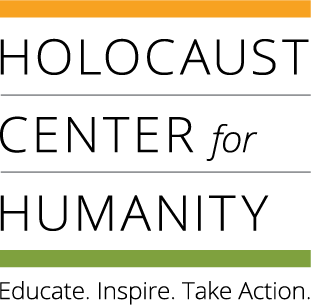
Image: Pile of shoes discovered at Auschwitz-Birkenau upon liberation, 1945. Image courtesy of the Auschwitz Museum.
Common Core State Standards addressed by this Overview Lesson
Ghettos & Camps
On September 1, 1939, the German army invaded Poland, which marked the beginning of World War II. Hitler’s goal was to secure more land for the German people and to carry out Nazi racial policies. The Nazis swiftly conquered country after country in Europe.
The Nazis and their collaborators forced Jews to move into crowded, often enclosed, areas called ghettos. Ghettos isolated Jews by separating them from the general population. Over 1,000 ghettos were set up throughout Nazi-occupied territories. In the Warsaw ghetto in Poland, more than 400,000 Jews were packed into an area of 1.3 square miles, with an average of over 7 people per room. With insufficient food and medicine, tens of thousands starved to death or died of disease in the ghettos.
In June 1941, Germany invaded the Soviet Union, breaking their alliance in their co-occupation of Poland. Soon after the invasion, mobile killing units (Einsatzgruppen), special groups of Nazi SS and police following the German military, commenced the mass murder of Soviet Jews. With support from local civilians and police, the Einsatzgruppen went from town to town massacring Jews. In all, they killed at least 1.5 million Jews in a “Holocaust by bullets,” as well as tens of thousands of political opponents, partisans, Roma/Sinti and disabled persons.
In January 1942, at the Wannsee Conference, high-ranking Nazi Party and German officials met to discuss “The Final Solution to the Jewish Question” – the Nazi plan to get rid of Jews through systematic mass murder west of the Soviet Union. Ghetto occupants were shot and killed, or deported, usually by train, to forced labor camps where treatment was brutal, or to death camps.
The largest of these “death camps” was Auschwitz-Birkenau in Poland, which by spring 1943 had four poison gas chambers disguised as showers. Up to 6,000 Jews were gassed there each day. An estimated 1.1 million people were murdered at Auschwitz between 1940 and 1945, including more than a million Jews and tens of thousands of Roma, Poles and Soviet prisoners of war.
In addition to six death camps (Auschwitz-Birkenau, Majdanek, Sobibor, Treblinka, Chelmno, and Belzec), there were thousands of concentration camps, forced labor camps, and transit camps where treatment was brutal. Over 6 million Jews and millions of others were murdered in the Holocaust.
Ghettos - Holocaust Survivor Video Testimony Clips
Camps - Holocaust Survivor Video Testimony Clips
Questions
- Both before, and particularly after Kristallnacht in November 1938, German Jews knew they were not welcome, and many who were able to do so, including the family of Anne Frank, fled to neighboring countries outside of Germany. How does the reading in this section impact your understanding of the plight of such German Jewish refugees?
- A) What resources and personnel do you think were needed to isolate, transport and murder millions of humans? Make a list of all of the people you think were involved. B) Alternatively, and/or in conjunction with the question above, assess and define the responsibility of people and institutions included here.
- How much assistance did the SS and its help ers receive from non-Germans? From the German military? From local populations?
- Given the prevalence today of the internet, television, social media and other technology that did not exist in the 1940s, do you think something like the Holocaust could happen today? Give a short description of why or why not.
- In Fred Kahn’s video clip testimony, he describes seeing, without reaction, dead bodies lying outside on the streets on his march through the Riga ghetto. How is it possible for a young boy to see dead bodies on streets without significantly reacting?
- Why do you think Ann Birulin’s mother’s words to her, “If you will live, through you I will live” meant so much to her?
- Why do you think Ann Kaye becomes so emotional describing her experience around being tattooed at one of the camps? Do you, or a family member, have memories that are too painful to discuss with others? Why do you think survivors like Ann Kaye are willing to share such painful memories with strangers? As witnesses/listeners/recipients of this testimony, what is our responsibly to Ann and to others?
